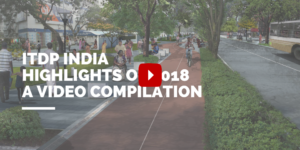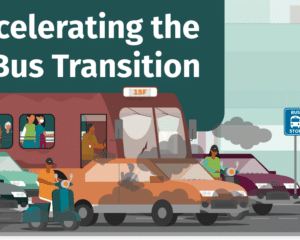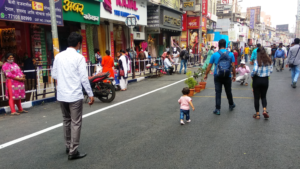The Union Budget 2022 is forward-looking and features several proposals to reform urban development and urban transport.
Here’s our take on what these proposals could do, why we’re glad for some, and what we recommend for others.
“Modernization of building byelaws, Town Planning Schemes (TPS), and Transit Oriented Development (TOD) will be implemented. This will facilitate reforms for people to live and work closer to mass transit systems. The Central Government’s financial support for mass transit projects and AMRUT scheme will be leveraged for formulation of action plans and their implementation for facilitating TOD and TPS by the states.”
Why we’re glad
If done right, modern building byelaws can help create mixed, compact neighbourhoods; eliminate or decrease parking minimums; set guidelines for more active street edges, leading to more safe, lively, and vibrant streets.
TPS would densify urban street networks with smaller block sizes, thus, people can comfortably walk and cycle.
TOD would bring people closer to public transport and improve their access to work, education, and other opportunities.
“For developing India specific knowledge in urban planning and design, and to deliver certified training in these areas, up to five existing academic institutions in different regions will be designated as centres of excellence.”
Why we’re glad
The centres would produce experts who can partner with local governments to create cities that work for everyone—cities that are safe, accessible, and vibrant!
“We will promote a shift to use of public transport in urban areas. This will be complemented by clean tech and governance solutions, special mobility zones with zero fossil-fuel policy, and EV vehicles.”
Why we’re glad
High-quality public transport helps more people move at a relatively low cost. Look at Singapore, where people rely on buses and metros to commute everywhere!
By discouraging fossil fuel use, people may be inclined to opt for better alternatives—walking, cycling, and public transport—thereby reducing carbon emissions and taking us closer to our COP26 commitment.
“PM GatiShakti Master Plan for Expressways will be formulated in 2022-23 to facilitate faster movement of people and goods. The National Highways network will be expanded by 25,000 km in 2022-23. 20,000 crore will be mobilized through innovative ways of financing to complement the public resources.”
We recommend
Our highways are hotspots for road crash deaths—especially that of pedestrians—because of the high vehicle speeds.
On highway stretches that pass through cities, slow down vehicular speeds through appropriate traffic calming measures. Create safe crossings and intersections for pedestrians and cyclists.
Road deaths are preventable. Let’s aim for Vision Zero!
“Innovative ways of financing and faster implementation will be encouraged for building metro systems of appropriate type at scale. Multimodal connectivity between mass urban transport and railway stations will be facilitated on priority. Design of metro systems, including civil structures, will be re-oriented and standardized for Indian conditions and needs.”
We recommend
Metros are expensive to build for ANY city. Our focus should be on making existing metros more accessible for everyone—provide frequent buses as feeders to the station, install public sharing bicycle docks, and create safe cycle tracks and footpaths so people can conveniently reach there. Informal public transport modes—e-rickshaws, share autos, vans—can also bring more riders for the metro.
“By the time of India @ 100, nearly half our population is likely to be living in urban areas. To prepare for this, orderly urban development is of critical importance…For this, on the one hand we need to nurture the megacities and their hinterlands to become current centres of economic growth. On the other hand, we need to facilitate tier 2 and 3 cities to take on the mantle in the future. This would require us to reimagine our cities into centres of sustainable living with opportunities for all, including women and youth. “
We recommend
Connect people and opportunities with robust and attractive infrastructure for walking, cycling, and public transport. Reduce dependence on personal motor vehicle use. Create vibrant streets and open public spaces where people can sit, linger, take a walk, cycle, support local businesses, and have fun! Our urban areas need that to become thriving centres for life.
“Considering the constraint of space in urban areas for setting up charging stations at scale, a battery swapping policy will be brought out and inter-operability standards will be formulated. The private sector will be encouraged to develop sustainable and innovative business models for ‘Battery or Energy as a Service’. This will improve efficiency in the EV ecosystem.”
We recommend
Batteries are why electric buses are SO expensive and unaffordable for cities right now. That’s why India should first engage with private players to produce low-cost batteries for e-buses and e-rickshaws, before they focus on personal motor vehicles.
‘Battery swapping policy’ eliminates the need for charging infra, but still doesn’t solve the bigger problem. Personal motor vehicles choke our streets with traffic, and electrifying them will reduce pollution, NOT congestion.
Our Verdict
With a focus on electrification, Budget 2022 holds promise for a better future, that would NOT be powered by fossil fuels. With TPS and TOD, cities can create more mixed, compact neighbourhoods that are walkable, cyclable, and well-serviced by high-quality frequent public transport, where people can safely and comfortably access work and play opportunities.
With the support of the Union Budget, Indian cities have immense potential to turn into thriving centres for life. Fingers crossed that this year is the beginning of big transformations.
Recent Blogs
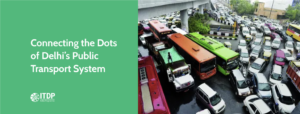
Connecting the Dots of Delhi’s Public Transport System
Find how the intricate network of Delhi’s public transport system and its ongoing efforts enhance connectivity, improve accessibility, and provide a seamless travel experience for millions of commuters in the bustling metropolis.”
Pune, Coimbatore and Chennai Selected as India’s ‘Smart Cities’
Pune, Coimbatore, and Chennai emerge as India’s Smart Cities, paving the way for sustainable urban development and innovative solutions. Explore their strategies and initiatives towards building smart and livable cities for the future.
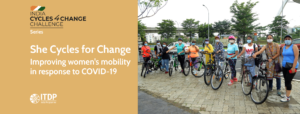
She Cycles for Change
Join us on a journey with inspiring women who are cycling for change. Discover their stories of empowerment, resilience, and how they are transforming cities by advocating for cycling as a sustainable mode of transport.
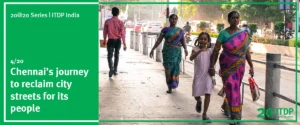
Chennai’s journey to reclaim city streets for its people
Chennai’s remarkable journey towards reclaiming city streets for its people. Uncover the inspiring initiatives and transformative efforts that are reshaping the urban landscape and prioritizing people-centered mobility.
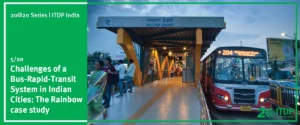
Challenges of a Bus-Rapid-Transit System in Indian Cities: The Rainbow case study
Learn from the Rainbow case study to understand the key considerations and solutions for building efficient and sustainable urban transportation systems.

